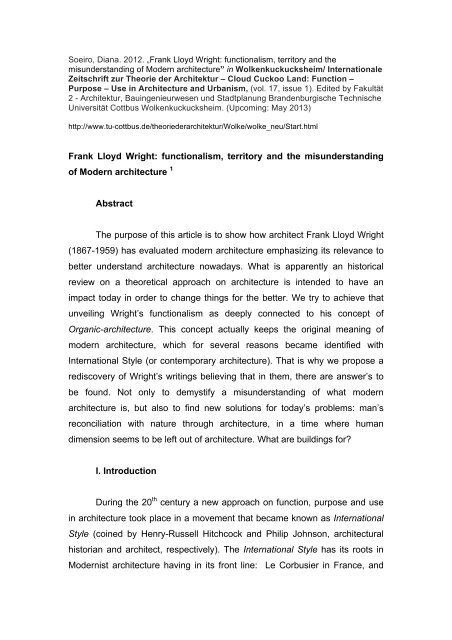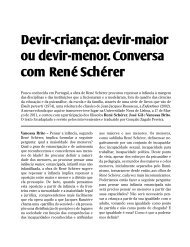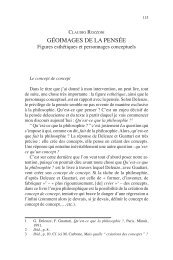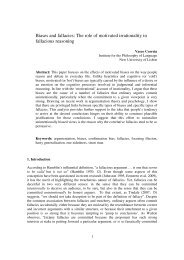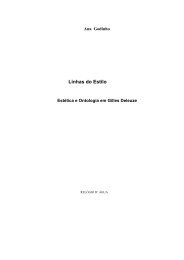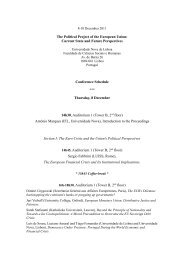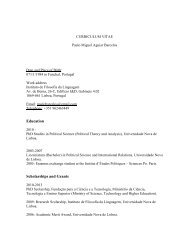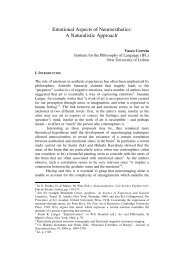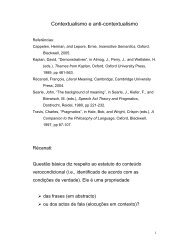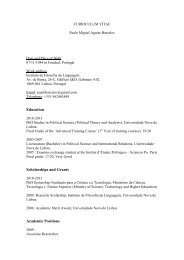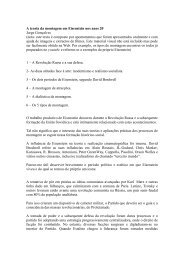Frank Lloyd Wright: functionalism, territory and the ... - IFL
Frank Lloyd Wright: functionalism, territory and the ... - IFL
Frank Lloyd Wright: functionalism, territory and the ... - IFL
You also want an ePaper? Increase the reach of your titles
YUMPU automatically turns print PDFs into web optimized ePapers that Google loves.
Soeiro, Diana. 2012. „<strong>Frank</strong> <strong>Lloyd</strong> <strong>Wright</strong>: <strong>functionalism</strong>, <strong>territory</strong> <strong>and</strong> <strong>the</strong><br />
misunderst<strong>and</strong>ing of Modern architecture” in Wolkenkuckucksheim/ Internationale<br />
Zeitschrift zur Theorie der Architektur – Cloud Cuckoo L<strong>and</strong>: Function –<br />
Purpose – Use in Architecture <strong>and</strong> Urbanism, (vol. 17, issue 1). Edited by Fakultät<br />
2 - Architektur, Bauingenieurwesen und Stadtplanung Br<strong>and</strong>enburgische Technische<br />
Universität Cottbus Wolkenkuckucksheim. (Upcoming: May 2013)<br />
http://www.tu-cottbus.de/<strong>the</strong>oriederarchitektur/Wolke/wolke_neu/Start.html<br />
<strong>Frank</strong> <strong>Lloyd</strong> <strong>Wright</strong>: <strong>functionalism</strong>, <strong>territory</strong> <strong>and</strong> <strong>the</strong> misunderst<strong>and</strong>ing<br />
of Modern architecture 1<br />
Abstract<br />
The purpose of this article is to show how architect <strong>Frank</strong> <strong>Lloyd</strong> <strong>Wright</strong><br />
(1867-1959) has evaluated modern architecture emphasizing its relevance to<br />
better underst<strong>and</strong> architecture nowadays. What is apparently an historical<br />
review on a <strong>the</strong>oretical approach on architecture is intended to have an<br />
impact today in order to change things for <strong>the</strong> better. We try to achieve that<br />
unveiling <strong>Wright</strong>’s <strong>functionalism</strong> as deeply connected to his concept of<br />
Organic-architecture. This concept actually keeps <strong>the</strong> original meaning of<br />
modern architecture, which for several reasons became identified with<br />
International Style (or contemporary architecture). That is why we propose a<br />
rediscovery of <strong>Wright</strong>’s writings believing that in <strong>the</strong>m, <strong>the</strong>re are answer’s to<br />
be found. Not only to demystify a misunderst<strong>and</strong>ing of what modern<br />
architecture is, but also to find new solutions for today’s problems: man’s<br />
reconciliation with nature through architecture, in a time where human<br />
dimension seems to be left out of architecture. What are buildings for?<br />
I. Introduction<br />
During <strong>the</strong> 20 th century a new approach on function, purpose <strong>and</strong> use<br />
in architecture took place in a movement that became known as International<br />
Style (coined by Henry-Russell Hitchcock <strong>and</strong> Philip Johnson, architectural<br />
historian <strong>and</strong> architect, respectively). The International Style has its roots in<br />
Modernist architecture having in its front line: Le Corbusier in France, <strong>and</strong>
Ludwig Mies van der Rohe <strong>and</strong> Walter Gropius in Germany. As much as we<br />
can discuss if it’s possible to assert <strong>the</strong> existence of a “style”, <strong>the</strong> International<br />
Style movement was grounded in a specific underst<strong>and</strong>ing of what Modern<br />
architecture stood for to <strong>the</strong> extent where, historically, International Style<br />
became a synonym of Modern architecture.<br />
We intend to show that this equivalence between International Style<br />
<strong>and</strong> Modern architecture is an historical misunderst<strong>and</strong>ing that for specific<br />
reasons, that we will discuss, is sustained up until today to <strong>the</strong> point where<br />
nowadays <strong>the</strong>re is not even an awareness that it is so. In order to unravel this<br />
misunderst<strong>and</strong>ing, we will focus on <strong>the</strong> forgotten <strong>Frank</strong> <strong>Lloyd</strong> <strong>Wright</strong>’s writings<br />
– that have long been forgotten precisely because of <strong>the</strong> above-mentioned<br />
historical misunderst<strong>and</strong>ing - in particular “In Order to Be Modern” (1930)” <strong>and</strong><br />
“Organic Architecture Looks at Modern Architecture” (1952).<br />
Theoretically, one of <strong>Wright</strong>’s strongest arguments is his distinction<br />
between rules <strong>and</strong> principles: rules can be imitable world-wide because <strong>the</strong>y<br />
can be repeated anywhere reproducing <strong>the</strong> same (International Style);<br />
principles st<strong>and</strong> on <strong>the</strong>ir own <strong>and</strong> are impossible to imitate because <strong>the</strong>y<br />
relate with uniqueness (“Organic architecture”). Consequently, both<br />
approaches do relate with <strong>territory</strong> <strong>and</strong> with <strong>the</strong> l<strong>and</strong> in two dramatically<br />
different ways concerning its function <strong>and</strong> use. This means that in order for us<br />
to think <strong>functionalism</strong> in architecture we have to think about <strong>territory</strong> <strong>and</strong> l<strong>and</strong>.<br />
We will be able to remember that <strong>Wright</strong> himself asserted <strong>the</strong> principles<br />
of Modern architecture that due to particular historical circumstances were<br />
“converted” into what became known as International Style that little had in<br />
common with <strong>the</strong> initial underst<strong>and</strong>ing of <strong>Wright</strong>’s “Modern architecture” – to<br />
<strong>the</strong> point where <strong>Wright</strong> changes <strong>the</strong> name of his architectural approach from<br />
“Modern architecture” to “Organic architecture”. This “conversion” is related<br />
with different perspectives on old concepts widely discussed in any art form:<br />
repetition, mechanics, style <strong>and</strong> imitation. Concerning architecture <strong>the</strong>se do<br />
end up having a strong impact shaping our daily life’s <strong>and</strong> that is why it is<br />
crucial to discuss <strong>the</strong>m in order to provide a renovated approach so <strong>the</strong>y can<br />
better serve <strong>the</strong> public interest, proving new solutions to old problems.<br />
Along with <strong>Wright</strong> we will look for new solutions in order to approach<br />
<strong>functionalism</strong> today so that architecture does not dismiss cultural quality <strong>and</strong>
user experience, reflecting on where does <strong>the</strong> functionalist quantitative<br />
approach has its roots, why was art rejected as a surplus <strong>and</strong> why was is it<br />
that <strong>the</strong> functionalist approach was not only criticized by <strong>the</strong>orists but also,<br />
strongly, by architect <strong>Frank</strong> <strong>Lloyd</strong> <strong>Wright</strong>. Accordingly, a renewed interest in<br />
underst<strong>and</strong>ing <strong>the</strong> development of terminologies in <strong>the</strong> 20 th century is<br />
essential.<br />
II. On International Style<br />
In it’s founding year 2 , in 1929, Alfred Barr (1902-1981) invited Philip<br />
Johnson (1906-2005), to be head of Department of Architecture <strong>and</strong> Design at<br />
<strong>the</strong> Museum of Modern Art (New York), though Johnson declared knowing<br />
nothing about architecture. For <strong>the</strong> next two years both Johnson <strong>and</strong> Barr,<br />
along with Hitchcock (1903-1987), travelled all over Europe by car educating<br />
<strong>the</strong>mselves on architecture. The experience culminated in an exhibition at <strong>the</strong><br />
Museum of Modern Art in 1932, titled “International Style” from which resulted<br />
a book. Reflecting back on what happened, says Johnson in 1995:<br />
“The International Style had a longer life, it seems to me now, than<br />
ever it deserved”. 3 The reason for Johnson to believe so is that though<br />
<strong>the</strong> exhibition didn’t have much public (<strong>and</strong> media coverage almost<br />
null) “its impact was huge in <strong>the</strong> architectural world” causing “endless<br />
discussion <strong>and</strong> fights within <strong>the</strong> profession”. 4<br />
The method preceding <strong>the</strong> exhibition could hardly be more modern<br />
since it dismissed everything that happened before, looking at <strong>the</strong> present as<br />
if everything that ever was, was contained in a “now” moment.<br />
As <strong>the</strong>y stated back in 1932, <strong>the</strong> strongest opposition to <strong>the</strong> Style came<br />
from <strong>the</strong> commercially successful modernistic architects who had <strong>the</strong> cult of<br />
individualism (particularly <strong>the</strong> American ones). 5 As Johnson states in 1995,<br />
one of <strong>the</strong> most discussed topics was <strong>the</strong> fact that <strong>the</strong>y had stated that <strong>the</strong><br />
Modern movement was a “style” similar to Gothic or Baroque. 6
“In <strong>the</strong> nineteenth century <strong>the</strong>re was always not one style, but “styles”,<br />
<strong>and</strong> <strong>the</strong> idea of “styles” implied a choice. The individualistic revolt of <strong>the</strong><br />
first modern architects destroyed <strong>the</strong> prestige of <strong>the</strong> “styles” but it did<br />
not remove <strong>the</strong> implication that <strong>the</strong>re was a possibility of choice<br />
between one aes<strong>the</strong>tic conception of design <strong>and</strong> ano<strong>the</strong>r. (…) Today a<br />
single new style has come into existence.” 7<br />
At this point we are able to get that Johnson <strong>and</strong> Hitchcock’s point is<br />
that, though one of <strong>the</strong> characteristics of modernity is to each individual his<br />
style, in reality, if actual structures are carefully observed with an<br />
archaeologist’s eye, it is possible to describe similar underlying principles of<br />
growth structure. 8<br />
What <strong>the</strong>y are both trying to do is to look forward as if <strong>the</strong>y’re looking<br />
back, in an effort of trying to anticipate “something”, that <strong>the</strong>y identify as a<br />
“Style”, which <strong>the</strong>y also refer to, several times, as: “contemporary style”.<br />
At this point we will stop to try to underst<strong>and</strong> what is at stake in<br />
Johnson <strong>and</strong> Hitchcock’s proposal. On one h<strong>and</strong>, “International Style” <strong>and</strong><br />
“contemporary style” 9 are <strong>the</strong>refore used as synonyms; on <strong>the</strong> o<strong>the</strong>r h<strong>and</strong>,<br />
“International Style” is what unveils what modernity truly is.<br />
Several questions surface: does this mean that modernity never<br />
existed <strong>and</strong> it was all <strong>the</strong> time, a style (an international one)? And if that is so,<br />
what is modernity, ie. why was it ever possible to define modernity as such if<br />
<strong>the</strong>re were only individualists? Why should <strong>the</strong> tag “International Style” be<br />
more accurate to use, historically, than that of Modern? To this, authors say:<br />
“This contemporary style, which exists throughout <strong>the</strong> world, is unified <strong>and</strong><br />
inclusive, not fragmentary <strong>and</strong> contradictory like so much of <strong>the</strong> production of<br />
<strong>the</strong> first generation of modern architects.” 10<br />
Historically, this will generate a grounding misunderst<strong>and</strong>ing on what<br />
modern architecture was meant to be, what it was, <strong>and</strong> how it historically<br />
gotten its definition. And that’s where <strong>Frank</strong> <strong>Lloyd</strong> <strong>Wright</strong> (1867-1959) writings<br />
can be helpful.<br />
<strong>Frank</strong> <strong>Lloyd</strong> <strong>Wright</strong> is not an architect’s name only. It also st<strong>and</strong>s for a<br />
great <strong>the</strong>orist of architecture. Moreover, his written work is essential to fully<br />
capture his architectural practice. It is not <strong>the</strong> case that one is only able to
grasp his work if one has already read something by <strong>Wright</strong>. But he had a<br />
vision <strong>and</strong> a concept of what Architecture should be <strong>and</strong> has taken <strong>the</strong> time<br />
<strong>and</strong> effort to put that into words - <strong>and</strong> that is also part of <strong>Wright</strong>’s work. That<br />
fully enables us to experience <strong>the</strong> Art of his Architecture as a whole, <strong>the</strong>n <strong>and</strong><br />
now.<br />
Having started to defend Modern-architecture (approached directly for<br />
<strong>the</strong> first time in a short article “In Order to Be Modern” (1930)) <strong>Wright</strong>’s<br />
concept will slowly shift over <strong>the</strong> years towards a different concept: Organic-<br />
architecture. The shifting is related with what <strong>Wright</strong> considers to have been a<br />
misunderst<strong>and</strong>ing <strong>and</strong> a misuse of what Modern-architecture stood for.<br />
Therefore, defending <strong>the</strong> same principles, he decides to rename his concept<br />
of Modern-architecture <strong>and</strong> called it Organic-architecture instead. This shift<br />
can be observed in his writings over <strong>the</strong> years. In 1952, around twenty years<br />
later after his 1930 article, he writes “Organic Architecture Looks at Modern<br />
Architecture” (1952) explaining in what way Modern Architecture has become<br />
Organic Architecture <strong>and</strong> also why he, <strong>Frank</strong> <strong>Lloyd</strong> <strong>Wright</strong>, refuses to be<br />
referred to as “modern”. Why is “modern” architecture not Modern-architecture<br />
anymore?<br />
We will now focus almost exclusively on <strong>Wright</strong>’s words since<br />
references supporting this concept of modern architecture are hard to find.<br />
Full-attention is given <strong>the</strong>n to <strong>the</strong> author himself.<br />
III. What is Modern-architecture<br />
In 1941, Sigfried Giedion (1888-1968) wrote a book that become a<br />
reference on <strong>the</strong> history of modern architecture “Space, Time & Architecture:<br />
<strong>the</strong> growth of a new tradition”. In it, Giedion dedicates a long chapter to<br />
<strong>Wright</strong>’s architecture covering <strong>the</strong> beginning of his career, how his idea of a<br />
house that spread from a central core always remained throughout his career,<br />
how he used <strong>the</strong> cruciform <strong>and</strong> <strong>the</strong> elongated plan, what was <strong>Wright</strong>’s<br />
meaning of organic, <strong>the</strong> importance of his relation with nature, <strong>and</strong> his<br />
influence in European architecture. Later on, in 1952, <strong>Wright</strong> would write in a<br />
letter to <strong>the</strong> acclaimed north American architecture critic Lewis Mumford<br />
(1895-1990):
“I am beginning to feel that HISTORY – at best – is made by some man<br />
studying a profile seen from where he sits. At worst it is likely false. (…)<br />
Such history as I’ve read (by Gideon 11 [sic], say) <strong>and</strong> from many pens<br />
is so specious a pretense of knowledge – that my gorge rises as I read.<br />
(…) History? A post-mortem. Of course. (…) The truth of <strong>the</strong> whole<br />
affair is so encrusted with Bauhaus, Museum of Modern Art, Hitchcock<br />
<strong>and</strong> Johnson, provincial imports from abroad <strong>and</strong> commercialization of<br />
<strong>the</strong> original ideas that any post mortem held by anyone (except one in<br />
<strong>the</strong> know by experience like yourself) is phony or bogus.” 12<br />
What was it that <strong>the</strong>y had gotten wrong, considering that Giedion, not<br />
ironically, presents him as a genius of architecture? 13<br />
<strong>Wright</strong> defines for <strong>the</strong> first time what Modern-architecture is in an article<br />
titled “In Order to be Modern”, published by Architectural Progress, in<br />
December 1930. In it, he creates <strong>the</strong> concept of modern by opposing it to that<br />
of “<strong>the</strong> Past of <strong>the</strong> Past”. What defines this architecture of <strong>the</strong> Past? “Post <strong>and</strong><br />
Beam, Weight <strong>and</strong> Mass, [where] <strong>the</strong>y are one <strong>and</strong> one that makes two”. And<br />
what about Modern-architecture? Modern Architecture is “<strong>the</strong> one plus one<br />
that still makes one” resulting as a “plastic Whole”. 14 What sense can we<br />
make of this?<br />
One key element in <strong>Wright</strong>’s concept of modern is his underst<strong>and</strong>ing of<br />
what a wall used to be (in <strong>the</strong> Past) <strong>and</strong> what a modern wall is: “Walls as solid<br />
walls are vanishing”. In his own words, in <strong>the</strong> Age of Democracy, men does<br />
not need to ““box up” or “hole in” for protection” because <strong>the</strong>re are no Slaves<br />
<strong>and</strong> Masters <strong>and</strong> we are no longer Savage animals. We should <strong>the</strong>refore<br />
“master lightness – openness” <strong>and</strong> exert “true sun-acceptance” instead. An<br />
Architect is also encouraged by <strong>Wright</strong> to see “<strong>the</strong> Earth as a poignantly<br />
beautiful place for human Life” <strong>and</strong> everything that Man builds should be<br />
“inspired by Nature in this sense”. 15<br />
Also in 1952, reflecting on modern architecture, <strong>Wright</strong> declares:<br />
“Modern-architecture is <strong>the</strong> offspring of Organic-architecture: an offspring,<br />
already emasculate <strong>and</strong> commercialized, in danger of becoming a Style”. 16<br />
Between 1930 <strong>and</strong> 1952 <strong>Wright</strong> slowly develops <strong>the</strong> concept of Organic-
architecture while criticizing strongly <strong>the</strong> orientation modern architecture is<br />
taking. In this same article, published by The Architectural Record in May<br />
1952, “Organic Architecture Looks At Modern Architecture”, <strong>Wright</strong> describes<br />
<strong>the</strong> change that <strong>the</strong> term “modern” has went through, becoming<br />
unrecognizable to his own eyes, to <strong>the</strong> extent that a new concept is<br />
dem<strong>and</strong>ed in order to replace its initial meaning: Organic-architecture.<br />
But what was “modern architecture”?<br />
IV. What is “modern architecture”<br />
“Modern architecture” is what <strong>Wright</strong> briefly names as “<strong>the</strong> box nude”,<br />
<strong>the</strong> architecture that has become a style <strong>and</strong> has been commercialized<br />
(lowering its quality st<strong>and</strong>ards becoming a mass architecture). His point is that<br />
Modern-architecture between 1893-1900 appeared as a great negation of<br />
European influences fully embodying America’s character. It had<br />
characteristics that were original <strong>and</strong> appealing: startlingly clean <strong>and</strong> “stream-<br />
lined” “effects”. A few years later, by 1910 <strong>the</strong>se principles were seized upon<br />
in Germany, more notably by Bauhaus movement. Bauhaus embodied <strong>the</strong>se<br />
principles of American architecture but has expressed <strong>the</strong>m at its worse,<br />
resulting as <strong>the</strong> opposite of what Modern-architecture stood for, that is, as<br />
Fascism: “The streamlined novelty of <strong>the</strong> original negation became fit for<br />
Fascism”. 17 Why? Because it was a two-dimensional architecture using a bare<br />
facade, <strong>the</strong> “box nude”, “dedicated to <strong>the</strong> Machine”. 18 The Machine<br />
symbolizes in <strong>Wright</strong>’s language <strong>the</strong> process where <strong>the</strong> easiest, fastest <strong>and</strong><br />
cheapest way of making a structure is what decides how <strong>the</strong> structure ends<br />
up being, instead of <strong>the</strong> o<strong>the</strong>r way around. Not that <strong>the</strong> structure has to be <strong>the</strong><br />
most expensive one, but firstly, <strong>the</strong> architect conceives a structure according<br />
to function, site, harmony with Nature, taking <strong>the</strong> most of natural resources,<br />
etc <strong>and</strong> only <strong>the</strong>n he should take time to adjust it to budget issues pondering<br />
on eventual technical difficulties. Because each structure is a challenge - <strong>and</strong><br />
not a mechanized repetition where <strong>the</strong> uniqueness of an architect’s gesture is<br />
lost or where <strong>the</strong> individual is not <strong>the</strong> architect’s first priority.<br />
What happened to Modern-architecture? <strong>Wright</strong> calls it a “sterilization” -<br />
political <strong>and</strong> economically profitable both for politicians <strong>and</strong> architects:
“Architectural careers (...) became quick. The true amateur, sterilized<br />
owing to this revival of <strong>the</strong> box-facade by accredited schools – <strong>and</strong><br />
names – is thus made “safe”. Grateful for this sterilization, if for no<br />
o<strong>the</strong>r reason, our leading universities toge<strong>the</strong>r with realtor “developers”<br />
<strong>and</strong> our swelling bureaucratic government are all ready to take over<br />
“Modern-architecture””. 19<br />
“Modern-architecture” is “<strong>the</strong> box nude” in <strong>the</strong> sense that originally,<br />
Modern-architecture came as <strong>the</strong> negation of <strong>the</strong> architecture of “<strong>the</strong> Past”,<br />
namely European architecture, where solid walls took central role (eventually<br />
with ornament). The two-dimensional bare facade takes <strong>the</strong> clean <strong>and</strong><br />
streamlined “effect” 20 of Modern-architecture (bringing back “<strong>the</strong> box”) using<br />
<strong>the</strong> features that initially made Modern-architecture truly original, truly<br />
American, truly Democratic, privileging <strong>the</strong> human scale, all different kinds of<br />
people living toge<strong>the</strong>r, <strong>the</strong> environment <strong>and</strong> <strong>the</strong> American open horizon. “This<br />
mixture of negation with negation is, as of today, what is called “Modern-<br />
architecture””. 21<br />
There was <strong>the</strong> European box; <strong>the</strong>n Modern-architecture rose in<br />
America redefining <strong>the</strong> concept of wall by intercepting different horizontal<br />
levels creating clean, streamlined, three-dimensional structures (negating <strong>the</strong><br />
box); <strong>and</strong> <strong>the</strong>n with Bauhaus movement <strong>the</strong> box appears again, this time<br />
completely bare. Not only bare, but white. And America embraced it for<br />
economical <strong>and</strong> political reasons.<br />
The extensive use of <strong>the</strong> colour white was also questioned by <strong>Wright</strong><br />
since he faced this ever appearing feature as a way to emphasize “<strong>the</strong> fact<br />
that it did not intend being a becoming feature of <strong>the</strong> ground upon which was<br />
put”. The relation with <strong>the</strong> ground <strong>and</strong> <strong>the</strong> Earth was a distant one. White was<br />
again one more feature that blurred individuality mechanizing <strong>the</strong> Art of<br />
Architecture “maintaining a white sepulture for unthinking mass-life”. The<br />
Machine was served by Architecture once again being so useful to<br />
commercial purposes: “no such cliché could have been made so useful to our<br />
American mass-education or serve our st<strong>and</strong>ard practice of quick<br />
commerce”. 22 The “modern” “old Box – undressed” is set up in any place,<br />
“regardless”, with a lid on top 23 <strong>and</strong> painted white. That is why it is so easy to
teach architects doing it <strong>and</strong> that is why it is Fascist. It does not challenge <strong>the</strong><br />
architect to make better Architecture, it does not distinguish people or sites<br />
<strong>and</strong> it disregards Nature (<strong>the</strong> ground). The feeling of conceiving each<br />
structure as unique, almost h<strong>and</strong>-made like, is lost in “modern architecture”.<br />
Architecture becomes a Style, an “international style”. 24 One fits all.<br />
As <strong>Wright</strong> puts it: “ ”Less is more” unless less, already little, becomes<br />
less than nothing at all <strong>and</strong> “much ado about nothing” ”. 25<br />
In Johnson <strong>and</strong> Hitchcock’s book, a book chapter is dedicated to<br />
<strong>functionalism</strong> <strong>and</strong> it refers mostly to <strong>the</strong> way critics perceive <strong>the</strong> interaction<br />
between <strong>functionalism</strong> <strong>and</strong> aes<strong>the</strong>tics. They view is that <strong>the</strong> aes<strong>the</strong>tic<br />
dimension has been put aside in modern architecture:<br />
“modern critics <strong>and</strong> groups of architects both in Europe <strong>and</strong> in America<br />
deny that <strong>the</strong> aes<strong>the</strong>tic element in architecture is important, or even<br />
that it exists. All aes<strong>the</strong>tic principles of style are to <strong>the</strong>m meaningless<br />
<strong>and</strong> unreal. This new conception, that building is science <strong>and</strong> not art,<br />
developed as an exaggeration of <strong>the</strong> idea of <strong>functionalism</strong>. (…) The<br />
doctrine of <strong>the</strong> contemporary anti-aes<strong>the</strong>tic functionalists (…) [basis’] is<br />
economic ra<strong>the</strong>r than ethical or archeological.” 26<br />
The statement is puzzling in <strong>the</strong> sense that it seems to go in <strong>the</strong> same<br />
direction as <strong>Wright</strong> goes. The (short) chapter continues with a strong critic on<br />
<strong>the</strong> growing dismissive role of aes<strong>the</strong>tics by critics. In <strong>the</strong> following chapters<br />
<strong>the</strong>y declare three principles as those that characterize International Style:<br />
volume; regularity instead of symmetry; <strong>and</strong> <strong>the</strong> avoidance of applied<br />
decoration. Judging on each one’s description, <strong>the</strong>y would fit <strong>the</strong> modernism<br />
label <strong>and</strong> that is when it occurs: do <strong>the</strong> authors intend to say that modernism<br />
should be replaced by International Style? Hitchcock gives us an answer that<br />
may clarify it when he refers to <strong>the</strong> “obituary aspect” of on International Style.<br />
“When did it died?” As we have seen before, just like in early modernism, <strong>the</strong><br />
International Style was not yet clearly visible, <strong>the</strong> International Style is what<br />
characterizes later modern architecture – <strong>and</strong> that, according to <strong>the</strong> author’s<br />
words one does not get exactly when did it end, except that in <strong>the</strong> late 60s it is<br />
still a valid label. 27
To <strong>Wright</strong>, though his vision on <strong>functionalism</strong> is visible, first of all he’s<br />
not referring to architecture critics but to architecture. Secondly, <strong>the</strong> label<br />
International Style is incorrect in <strong>the</strong> sense that is unnecessary in order to<br />
describe <strong>the</strong> modern movement. Architecture should focus on principles, not<br />
in rules (<strong>functionalism</strong>) or Style. The architect should look around in order to<br />
make <strong>the</strong> best possible architecture he can do, according to his <strong>and</strong> Nature’s<br />
own principles.<br />
We will now approach <strong>Wright</strong>’s conception of Organic-architecture in<br />
order to unveil what is <strong>the</strong> <strong>functionalism</strong> concept that is at stake in <strong>Wright</strong>’s<br />
perspective.<br />
V. What is Organic-architecture<br />
Organic was already a feature of <strong>Wright</strong>’s concept of Modern-<br />
architecture by 1930. The thing is that this feature was precisely <strong>the</strong> most<br />
affected by <strong>the</strong> Bauhaus interpretation of Modern-architecture (imported<br />
promptly by America). This is why <strong>Wright</strong> ab<strong>and</strong>ons <strong>the</strong> term “Modern-<br />
architecture” <strong>and</strong> replaces it by Organic-architecture.<br />
What defines Organic-architecture?<br />
“Roofs ei<strong>the</strong>r flat or pitched, hipped or gabbled”, “wide flat eaves”,<br />
ornament non-existant unless integral, walls become screens, <strong>the</strong> new<br />
open-plan spreads upon a concrete ground-mat. In short, “<strong>the</strong> whole<br />
structure intimate <strong>and</strong> wide upon <strong>and</strong> of <strong>the</strong> ground itself”. 28<br />
The uniqueness of Organic-architecture was its depth, its three-<br />
dimensional character where continuity played a key role. No more attics or<br />
basements. A new sense of space appropriate to human scale. “The interior<br />
space to be lived in became <strong>the</strong> reality of <strong>the</strong> whole performance. Building, as<br />
a box, was gone.” 29 The Machine dedicated to Architecture <strong>and</strong> not <strong>the</strong> o<strong>the</strong>r<br />
way around. This three-dimensional character was <strong>the</strong> main statement<br />
against Past architecture, <strong>the</strong> essence of it negation. This is why “<strong>the</strong> box<br />
nude” is, in <strong>Wright</strong>’s view, not only a violation of what was previously defined<br />
as Modern-architecture but also a receding towards <strong>the</strong> evolution of
Architecture – <strong>and</strong> Man itself. After slavery being abolished <strong>and</strong> we no longer<br />
need to protect ourselves from o<strong>the</strong>r animals, why go back? If in an era of<br />
Democracy man can elevate Architecture to an expression of Art why should<br />
it not do so?<br />
<strong>Wright</strong> gives an acute answer. Organic-architecture is profound – “too<br />
slow for popular purposes”. Consequently, <strong>the</strong> “preparation for architectural<br />
practice would be not only slow but far too difficult. Also, a discerning client<br />
was needed ra<strong>the</strong>r than a fashionable one”. 30 This shows <strong>Wright</strong>’s awareness<br />
of <strong>the</strong> complexity that Architecture involves. It is not just about buildings. It is<br />
about economics, politics, bureaucracy, architects, architecture students,<br />
architecture teachers, clients <strong>and</strong> business. But somehow, Architecture as an<br />
Art cannot get lost in <strong>the</strong> middle <strong>and</strong> an architect should be taught on how to<br />
remember this.<br />
What <strong>Wright</strong> underst<strong>and</strong>s is that when that is forgotten space looses its<br />
magic <strong>and</strong> man becomes a beating heart in <strong>the</strong> middle of “mechanized”<br />
concrete. Like if one was walking through a “plan-factorynds”. 31 That is why<br />
“Modern-architecture is Organic-architecture deprived of a soul”. 32 As for <strong>the</strong><br />
original concept of Modern-architecture <strong>Wright</strong> considers that it was<br />
“camouflaged or betrayed”. 33<br />
Sterilized, mechanized <strong>and</strong> white architecture became <strong>the</strong>refore a<br />
Style. And despite <strong>Wright</strong>’s vision on “any “international style” [that] would<br />
probably be a cultural calamity fit for Fascism but intolerable to democracy”<br />
that has bear out to be true.<br />
What <strong>Frank</strong> <strong>Lloyd</strong> <strong>Wright</strong> was aware of is that Architecture depends on<br />
a cultural frame of mind, because many different people <strong>and</strong> areas intersect.<br />
But at <strong>the</strong> end of <strong>the</strong> day, whe<strong>the</strong>r is money or fastness that moves you, you<br />
(we) are <strong>the</strong> one that has to live space <strong>and</strong> ei<strong>the</strong>r it protects you <strong>and</strong> cares for<br />
you, or not. Maybe <strong>Wright</strong> was right <strong>and</strong> “a cultural organism (like any o<strong>the</strong>r<br />
true organism) must grow. Growth is slow. It cannot be had like a box nailed<br />
up by <strong>the</strong> tyro internationally”. But more than fifty years have gone by since<br />
this statement <strong>and</strong> still it is pertinent to ask “why should a Get-rich-quick<br />
Society like ours take time <strong>and</strong> <strong>the</strong> extreme pains necessary to make an<br />
organism of anything”? 34
In 1966, Hitchcock acknowledges <strong>Wright</strong>’s Organic-architecture as a<br />
str<strong>and</strong> that has retained some independence of International Style (along with<br />
a few o<strong>the</strong>r movements) that he considers both to have complicated <strong>and</strong><br />
enriched <strong>the</strong> architectural scene. 35 It is <strong>the</strong>refore puzzling why in <strong>the</strong> 1932<br />
exhibition, organized by Johnson, he decided to show <strong>the</strong> work of Le<br />
Corbusier, Oud, Gropius, Mies van der Rohe <strong>and</strong>, by contrast, that of <strong>Wright</strong><br />
occupied <strong>the</strong> principal place in <strong>the</strong> exhibition.<br />
<strong>Wright</strong>’s concept of <strong>functionalism</strong> is related with that of <strong>territory</strong> <strong>and</strong><br />
l<strong>and</strong> (ground) being both closely connected with his belief that it was not<br />
possible to think architecture without considering its relation with Nature. Any<br />
structure is sustained by <strong>the</strong> ground <strong>and</strong> is inserted in a specific context that<br />
allows space to become a <strong>territory</strong> because of that a structure placed <strong>the</strong>re.<br />
Due to his mo<strong>the</strong>r’s influence <strong>Wright</strong> was a Transcendentalist 36 <strong>and</strong> an<br />
avid Emerson reader that highly valued Nature <strong>and</strong> man’s relation with nature.<br />
On Emerson says Reginald L. Cook:<br />
“Unlike Thomas Aquinas, Spinoza, Locke, <strong>and</strong> Kant, Emerson had no<br />
formal metaphysical system, <strong>and</strong> he was indifferent to dialectic <strong>and</strong><br />
controversial argument. He cultivated disciples nor proselytized, but<br />
aimed his thought to arouse. When he referred to <strong>the</strong><br />
transcendentalists as “collectors of <strong>the</strong> heavenly spark with power to<br />
convey <strong>the</strong> electricity to o<strong>the</strong>rs,” he characterized himself. He was more<br />
assertive than speculative, more affirmative than skeptical, more<br />
suggestive than explanatory. By temperament he was seer-like, in<br />
expression oracular, in tone scriptural.<br />
No slide rule can measure Emerson’s mind. It was as capacious as a<br />
pocket in a Yankee greatcoat <strong>and</strong> full of transcendental notions like<br />
Polarity, Compensation, Circles, <strong>the</strong> over-Soul <strong>and</strong> <strong>the</strong> Self-Reliance.”<br />
37<br />
In his essay “Nature” that Emerson has published anonymously, de<br />
defends a new vision of Nature strongly sustained by <strong>the</strong> vast American<br />
<strong>territory</strong> <strong>and</strong> l<strong>and</strong>scape: Nature is itself a divinity <strong>and</strong> men knows since ever<br />
its principles because he has <strong>the</strong> ability to find <strong>the</strong>m within himself; <strong>the</strong>refore,
Nature it is not one more component in <strong>the</strong> world, ruled by an universal law,<br />
about which new principles can be taught. 38<br />
An earlier but also significant influence on <strong>Wright</strong>’s architecture was<br />
Fröebel according whose principles <strong>Wright</strong> was raised on since his mo<strong>the</strong>r<br />
was an attentive reader of his manuals. Friedrich Fröbel (1772-1882) funded<br />
in 1837 <strong>the</strong> Kindergarten concept. Fröebel, after having studied for several<br />
years botanic <strong>and</strong> biology (which he started early in his youth <strong>and</strong> has<br />
continued all his life) defended that education is like a natural process; that<br />
<strong>the</strong> child is an organic whole that develops through his/ her creative activity,<br />
according to natural laws; also, that <strong>the</strong> universe, as a while is an organism<br />
<strong>and</strong> that <strong>the</strong> individual is an organic part of society; <strong>and</strong> that <strong>the</strong> universe as a<br />
while is an organism from which all smaller organism belong to. According to<br />
Fröebel, man is a self-expressive being that has to follow his inner calling. In<br />
order to bring that out in a kid, he has created “Fröebel’s presents” 39 , that<br />
seemed to have effectiveness in developing <strong>the</strong> child’s abilities. 40 Shapes,<br />
colours, cubes, lines <strong>and</strong> curves allowed <strong>the</strong> child to develop several diferente<br />
concepts <strong>and</strong> structures using <strong>the</strong> same simple elements. Fröebel refers to<br />
education precisely as a discovery of <strong>the</strong> Unity that <strong>the</strong> child has within<br />
herself, being <strong>the</strong> best she can to do is to “imitate nature’s logic”. 41 In that<br />
sense says Richard Maccormac, that <strong>Wright</strong>’s education has much in<br />
common with a Renaissance architect that conceives his work as an absolute<br />
value <strong>and</strong> an echo of universal architecture. As <strong>Wright</strong> states in his essay “In<br />
<strong>the</strong> Cause of Architecture”, “<strong>the</strong>re is no source so fertile, so suggestive, so<br />
helpful aes<strong>the</strong>tically for <strong>the</strong> architect as a comprehension of natural law.” 42<br />
Therefore, what Fröebel <strong>and</strong> Emerson have in common is that <strong>the</strong>re is<br />
no duality between man <strong>and</strong> nature (surrounding environment): acknowledge<br />
<strong>and</strong> respect environment’s integrity, in <strong>the</strong> sense that it was here before we<br />
were. <strong>Wright</strong> does identify with this <strong>and</strong> his creation of <strong>the</strong> concept Organic<br />
Architecture, against internationalism, not only concerns structure but also a<br />
way of doing “Architecture” in America: “Today Architecture is becoming an<br />
industry; it is no longer a great art. // Architecture is becoming a business in<br />
league with its own government for housing people wholesale – at retail<br />
prices.” 43 Therefore, “Style is <strong>and</strong> should be <strong>the</strong> character of what we are, not<br />
what <strong>the</strong> house-builder boys would have us be. Style is <strong>and</strong> should be <strong>the</strong>
expression of our free spirits.” 44 Architecture should not ignore History <strong>and</strong><br />
culture.<br />
In <strong>Wright</strong>’s perspective <strong>the</strong> house, is <strong>the</strong> main element from which<br />
Architecture grows from:<br />
“A house is a human circumstance in Nature, like a tree or <strong>the</strong> rocks of<br />
<strong>the</strong> hills; a good house is a technical performance where form <strong>and</strong><br />
function are made one; a house is integral to its site, a grace, not a<br />
disgrace, to its environment, suited to elevate <strong>the</strong> life of its individual<br />
inhabitants; a house is <strong>the</strong>refore integral with nature of <strong>the</strong> methods<br />
<strong>and</strong> materials used to build.” 45<br />
<strong>Wright</strong>’s description of “what is a house” explains why is it <strong>the</strong> basis of<br />
Organic Architecture, being <strong>the</strong> simplest architectural structure. The word<br />
“Organic” is <strong>the</strong>refore associated with <strong>the</strong> concept of architecture, defining it,<br />
<strong>and</strong> taking as its synonym “harmony”. Organic Architecture is a concept that<br />
states a certain form of beauty, indispensable to any art form, that is thought<br />
but having as its main reference, Nature:<br />
“The plant also builds; growing from seed to root, stem <strong>and</strong> branch, in<br />
order to carry <strong>the</strong> exquisite flower <strong>and</strong> consequent fruit. The tree itself<br />
rises to majesty. Congruity, continuity <strong>and</strong> plasticity we see as qualities<br />
throughout all natural building. Beauty is due to some mystic innate-<br />
power elemental as life is to life itself. Harmony is organic <strong>and</strong> comes<br />
forth to <strong>the</strong> human eye.” 46<br />
To <strong>Wright</strong>, architecture’s <strong>functionalism</strong> is architecture <strong>and</strong> nature,<br />
considered closely toge<strong>the</strong>r, because <strong>the</strong>y are inevitably entangled. And that<br />
is what Organic Architecture proposes.<br />
VI. Conclusion<br />
Again, <strong>Wright</strong> asked “why should a Get-rich-quick Society like ours<br />
take time <strong>and</strong> <strong>the</strong> extreme pains necessary to make an organism of<br />
anything”? 47 . And he adds: “The answer is yet to come” 48 said <strong>Wright</strong> in 1952.
And still, we are still waiting for that answer. What is here at stake in this<br />
paper is not an historical revision of <strong>Wright</strong>’s words but a reminder of a very<br />
sharp description of <strong>the</strong> state we are in. We claim it as a crucial departure<br />
point to start thinking nowadays about space <strong>and</strong> architecture in order to find<br />
a new direction where human character is considered.<br />
Nowadays, a new underst<strong>and</strong>ing of organic is occurring where for<br />
instance, organic shapes of micro-organism are shaped in computers <strong>and</strong><br />
<strong>the</strong>n blown out of proportions <strong>and</strong> that shape is <strong>the</strong> basis for a structure. Man<br />
is being expelled out of space by architecture. Useless, large spaces fit for an<br />
alien but now for <strong>the</strong> human shape where we look <strong>and</strong> feel like ants. We’re<br />
<strong>the</strong> new micro-organism. Architecture has made us smaller under <strong>the</strong> organic<br />
tag, but in order to be organic (in <strong>Wright</strong>’s sense) <strong>the</strong> connection with nature<br />
must not cease to exist. In a rapidly growing worldwide urban environment<br />
how can we preserve <strong>the</strong> connection between man <strong>and</strong> nature?<br />
We now have fifty years of experience of a “Get-rich-quick-Society”<br />
where architecture has changed a lot becoming a lot of things except slow.<br />
Built space is controlling us <strong>and</strong> not <strong>the</strong> o<strong>the</strong>r way around. Mechanized<br />
architecture takes place everyday as if no man was supposed to live in a built<br />
environment. Ethics <strong>and</strong> architecture do have a strong connection because<br />
<strong>the</strong> way we build can have an edifying effect in ourselves. As human beings<br />
we exist in space <strong>and</strong> time <strong>and</strong> architecture shapes <strong>the</strong>m. So in a way<br />
architecture shapes <strong>the</strong> future of human kind. And if that on one had seems<br />
like a blunt praise on architecture it is also a statement of its serious<br />
responsibility that should not be ignored. The more people are aware that this<br />
is <strong>the</strong> situation <strong>the</strong> more able <strong>the</strong>y will be to claim space to <strong>the</strong>mselves, as<br />
individuals. 49<br />
Though this “Get-rich-quick-Society” kind of architecture is being<br />
practiced at its extreme, for instance, in China <strong>and</strong> Dubai <strong>the</strong>re are<br />
exceptions. Swiss architect Peter Zumthor (b. 1943) seems to be <strong>the</strong> leader of<br />
this not-openly-expressed movement that is holding several young architects’<br />
attention. His work Vals spa (Therme Vals, Switzerl<strong>and</strong>, 1996) took six years<br />
to be completed <strong>and</strong> <strong>the</strong>refore st<strong>and</strong>s as a powerful statement to makes us<br />
underst<strong>and</strong> what “slow architecture” is. Perhaps this is <strong>the</strong> concept that<br />
nowadays most relates with <strong>Wright</strong>’s view on architecture. Will this new
generation of architects be able to embody a new vision for modern<br />
architecture <strong>and</strong> actually turn it into something solid?<br />
Perhaps Hitchcock has declared <strong>the</strong> obituary of International Style, but<br />
somehow historically, he remains living on ending up having a double <strong>and</strong><br />
ambiguous role, representing both contemporary architecture <strong>and</strong> modern<br />
architecture. What <strong>Wright</strong> reminds us is that modern architecture never was<br />
meant to be contemporary architecture. Perhaps Hitchcock is right <strong>and</strong> <strong>the</strong><br />
International Style exists no more, but with <strong>Wright</strong>’s Organic-architecture,<br />
nowadays, we do have a lot to learn <strong>and</strong> <strong>the</strong>refore his place among<br />
architecture (<strong>the</strong>ory, history <strong>and</strong> practice) should be claimed. With him, we<br />
can find out what was modern architecture <strong>and</strong> use his principles (not rules, or<br />
“Style”) to find new solutions for <strong>the</strong> future. And that’s <strong>Wright</strong>’s functionality’s<br />
usefulness: to help architecture finds it’s way again.<br />
1 This article had as its inspiration <strong>the</strong> third <strong>and</strong> fourth chapters of my PhD <strong>the</strong>sis titled “A cor<br />
2 Hitchcock, “Forward to <strong>the</strong> 1966 edition” in Hitchcock; Johnson, 1995 (1966; 1932), p. 19<br />
3 Johnson, “Forward to <strong>the</strong> 1995 edition” in Hitchcock; Johnson, 1995 (1966; 1932), p. 13-15<br />
4 idem, p. 15<br />
5 Hitchcock; Johnson, 1995 (1966; 1932), p. 30<br />
6 Johnson, “Forward to <strong>the</strong> 1995 edition” in Hitchcock; Johnson, 1995 (1966; 1932), p. 16<br />
7 idem, p. 34, 35<br />
8 idem, p. 37<br />
9 At that time <strong>the</strong> many discussion around “what is contemporary” still had not started yet, so<br />
perhaps we can read it simply as “<strong>the</strong> style that exists now”, though nowadays an<br />
underst<strong>and</strong>ing of <strong>the</strong> term has become both more confuse <strong>and</strong> complex.<br />
10 Hitchcock; Johnson,, 1995 (1966; 1932), p. 34, 35<br />
11 Despite <strong>the</strong> misspelling, as <strong>the</strong> book editor confirms, <strong>Wright</strong> does refer to Sigfried Giedion’s<br />
“Space, Time & Architecture: <strong>the</strong> growth of a new tradition” (1941)<br />
12 <strong>Wright</strong>; Mumford, 2001, p. 206, 207<br />
13 “<strong>Wright</strong> had always – up to <strong>the</strong> last – <strong>the</strong> inspiration of a genius that reached far beyond his<br />
own generation.” p. 427, also p. 398<br />
14 <strong>Wright</strong>, 1992a, p. 338<br />
15 <strong>Wright</strong>,1992a, p. 337<br />
16 <strong>Wright</strong>,1995, p. 46<br />
17 <strong>Wright</strong>,1995, p. 48<br />
18 ibidem<br />
19 <strong>Wright</strong>, 1995, p. 49<br />
20 <strong>Wright</strong>, 1995, pp. 48, 49<br />
21 <strong>Wright</strong>, 1995, p. 49<br />
22 <strong>Wright</strong>, 1995, p. 48<br />
23 <strong>Wright</strong>, 1995, p. 49<br />
24 <strong>Wright</strong>, 1995, p. 50<br />
25 <strong>Wright</strong>, 1995, p. 49<br />
26 Hitchcock; Johnson, 1995 (1966; 1932), p. 50, 51<br />
27 Hitchcock, “Forward to <strong>the</strong> 1966 edition” in Hitchcock; Johnson, 1995 (1966; 1932), p. 23<br />
28 <strong>Wright</strong>, 1995, p. 47<br />
29 <strong>Wright</strong>,1995, p. 48<br />
30 <strong>Wright</strong>, 1995, p. 49
31<br />
Wrigh, 1995, p. 50<br />
32<br />
<strong>Wright</strong>,1995, p. 49<br />
33<br />
<strong>Wright</strong>, 1995, p. 50<br />
34<br />
ibidem<br />
35<br />
Hitchcock, “Forward to <strong>the</strong> 1966 edition” in Hitchcock; Johnson, 1995 (1966; 1932), p. 23<br />
36<br />
Funded in New Engl<strong>and</strong> (EUA) by Ralph Emerson with an essay titled “Nature” (1836).<br />
37<br />
Cook,, “Introduction”, in Emerson, 1956<br />
38<br />
Emerson, 1956<br />
39<br />
http://www.froebelgifts.com/<br />
40<br />
MacCormac, 2005, p. 126<br />
41<br />
ibidem<br />
42<br />
idem, p. 127<br />
43<br />
<strong>Wright</strong>, 1995, p. 239<br />
44<br />
idem, p. 240<br />
45<br />
<strong>Wright</strong>, 1995, p. 242<br />
46<br />
<strong>Wright</strong>, 1995, pp. 348, 349<br />
47<br />
<strong>Wright</strong>, 1995, p. 50<br />
48 ibidem
Reference list<br />
Emerson, Ralph Waldo, Selected Prose <strong>and</strong> Poetry, (ed. Reginald L. Cook), Rinehart & Co.,<br />
Inc., USA, 1956<br />
Hitchcock, Henry-Russell; Johnson, Philip, The New International Style, New York/ London:<br />
W. W. Norton & Company, 1995 (1966; 1932)<br />
MacCormac, Richard, “Form <strong>and</strong> Philosophy – Froebel’s Kindergarten Training <strong>and</strong> <strong>Wright</strong>’s<br />
Early Work” (1974), in On <strong>and</strong> By <strong>Frank</strong> <strong>Lloyd</strong> <strong>Wright</strong> - A Primer of Architectural Principles,<br />
Robert Mccarter (ed.) , Phaidon Press Limited, China, 2005<br />
<strong>Wright</strong>, <strong>Frank</strong> <strong>Lloyd</strong> – Collected Writings, volume 1, 1894-1930, B.B. Pfeiffer (ed.), New York:<br />
Rizzoli, 1992<br />
- <strong>Frank</strong> <strong>Lloyd</strong> <strong>Wright</strong> – Collected Writings, volume 2, 1930-1932, B.B. Pfeiffer (ed.), New<br />
York: Rizzoli, 1992<br />
- <strong>Frank</strong> <strong>Lloyd</strong> <strong>Wright</strong> – Collected Writings, volume 3, 1931-1939, B.B. Pfeiffer (ed.), New<br />
York: Rizzoli, 1993<br />
- <strong>Frank</strong> <strong>Lloyd</strong> <strong>Wright</strong> – Collected Writings, volume 4, 1939-1949, B.B. Pfeiffer (ed.), New<br />
York: Rizzoli, 1994<br />
- <strong>Frank</strong> <strong>Lloyd</strong> <strong>Wright</strong> – Collected Writings, volume 5, 1949-1959, B.B. Pfeiffer (ed.), New<br />
York: Rizzoli, 1995<br />
<strong>Wright</strong>, <strong>Frank</strong> <strong>Lloyd</strong>; Mumford, Lewis, <strong>Frank</strong> <strong>Lloyd</strong> <strong>Wright</strong> & Lewis Mumford: thirty years of<br />
correspondence, New York: Princeton Architectural Press, 2001


